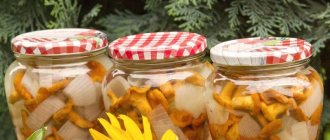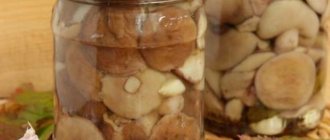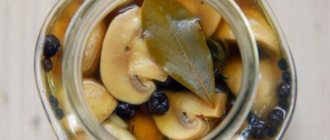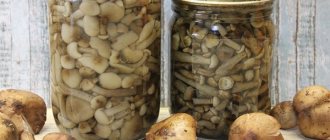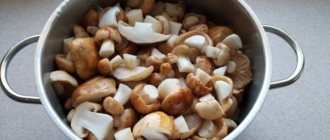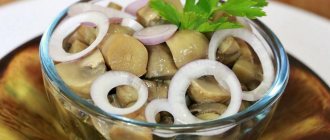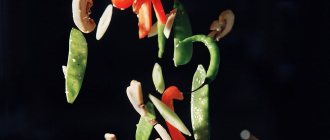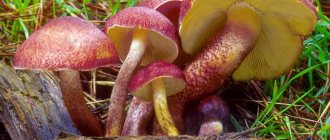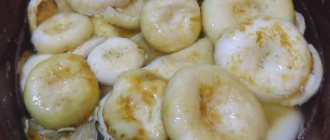What can be prepared from rows?
The most common varieties of sandpipers found in central Russia are the green sandpiper (greenfinch), the gray sandpiper and the red sandpiper. They have dense fleshy flesh, slightly darkening at the break. Sandpipers usually grow in large groups.
They are good fried, especially if fried with onions and potato slices. They can be marinated by adding to the marinade, in addition to vinegar and black peppercorns, 2-3 clove buds and 1-2 bay leaves. Then the taste and aroma of spices will overwhelm the characteristic sweetish taste of sandpiper, which not some people like.
Since the rows are edible mushrooms, they do not require pre-boiling or soaking. But they must be thoroughly washed before cooking to remove sand and small debris.
Sandpipers are also good in salted form. Usually they are salted in a “cold” way, placing thoroughly washed mushrooms in a plate-like layer on top in sterilized glass jars or ceramic dishes, and sprinkling each layer with salt. When all the mushrooms have been laid, you should salt the top layer, put a clean cotton rag scalded with boiling water on top, put a wooden circle on it (made of deciduous wood, also scalded with boiling water), and press down with pressure. The container with mushrooms should be stored in the refrigerator or cold cellar. In a few days they will release juice and become very heavy. You will be able to eat such salted sandpipers in about a month and a half. Sandpiper soups are usually not cooked, as they turn out much worse than soups from many other types of mushrooms.
Terms and conditions of storage of pickled poplars
The snack can be eaten after 30-40 days, from the moment of marinating. The product, sealed with plastic or glass lids, is edible for 12-18 months, with tin lids - 10-12 months.
Advice! To avoid oxidation of the lid and spoilage of the snack, you should give preference to plastic or glass material.
Storage conditions for pickled floodplains:
- dry, ventilated room;
- air temperature +8-10 °C;
- no direct sunlight.
Compliance with the technological process, the use of sterilized utensils, as well as ensuring optimal storage conditions guarantee the preservation of the taste properties and quality of pickled floodplains.
Taste qualities of the row
In general, it should be said that in terms of taste, row mushrooms are, of course, inferior to many mushrooms, primarily porcini, aspen, boletus, saffron milk caps, boletus, champignons, and chanterelles. Therefore, often even experienced mushroom pickers, who know well that these are edible mushrooms, do not collect sandpipers on principle. However, there are also mushroom pickers who like both the original “floury” aroma of such mushrooms and their sweetish taste.
- Number of servings: 2
- Preparation time: 20 minutes
- Cooking time: 20 minutes
Edible or not
Poplar rows or sandstones are delicious, completely edible mushrooms. Although not all mushroom pickers take them, preferring the more common ones. They have a sweetish, nutty flavor and a delicate mealy aroma. By properly preparing these mushrooms, you can get unusual healthy dishes that are aromatic and tasty. When fried, they resemble truffles. Salted and pickled sandpipers smell pleasantly like fresh cucumbers.
Sometimes in the literature poplars are called conditionally edible. You may find recommendations to soak the fruits for a day to get rid of bitterness. But in fact, this is not necessary, they have a pleasant aroma and taste like truffles. The bitterness is almost not felt; to get rid of it, you just need to remove the skin. Poplars can be fried, boiled, pickled, and salted. They are used to make soups, sauces, pates, and caviar.
The only downside to eating them is related to the soil in which they grow. Sand grains often get clogged into the plates. Therefore, it is recommended to rinse the collected fruits well before cooking and then soak them to get rid of sand. But if the mushroom is clean, you don’t have to do this.
How to cook sandbox mushrooms in a frying pan
The only drawback of these mushrooms is that they grow on sandy soils, so careful preliminary preparation is indispensable. The collected sandboxes need to be rinsed well and soaked in salted cold water for at least 3-4 hours, and preferably overnight. But the water needs to be changed periodically so that the sandpipers do not become sour. During this time, the plates and pores will open and the grains of sand will sink to the bottom. The easiest way is to simply fry the prepared mushrooms in a frying pan.
- Cook for 20 minutes from the moment of boiling, removing the foam.
- Rinse and leave to remove excess liquid.
- Place the mushrooms in a heated frying pan with oil. Fry.
- At the end of cooking, add salt, spices, pepper to taste. Cook for another 2 minutes.
Serve with potatoes or other side dish.
Most common types
In total, there are about 40 species of sandpipers, which have another name - rowers. They come in different colors - from grayish to brown. But there are only three most popular ones.
Greenfinch
The main difference between this species is its green color. It does not change even after prolonged heat treatment. The mushroom is edible, but in small doses and after soaking and cooking. You can add it to any dish. Bonus - it can be found before the first snow.
Gray sandpiper
Edible, gray in color. It is suitable for consumption after heat treatment. Dangerous in its raw form.
Red sandpiper
Conditionally edible - only after long and proper preparation it is suitable for consumption. It is red in color and has yellow flesh. Before cooking, soak in a saline solution for at least a day, then you can pickle, fry or boil.
Recipe for pickled sandpiper mushrooms
- sandpipers;
- water – 1000 ml;
- sugar – 1 tbsp. l.;
- salt – 2 tbsp. l.;
- vinegar – 50 ml;
- bay leaf – 1-2 pcs.;
- allspice – 5 pcs.
- Cover the mushrooms with water. Cook after boiling for 20 minutes, removing foam from time to time.
- Rinse. Pour water, add spices and cook for 30 minutes. At the very end, pour off the vinegar and stir. The mushrooms should settle to the bottom.
- Place the mushrooms in pre-sterilized jars and pour over the marinade.
Roll up, wrap and leave until cool. Place in a dark and cool place. The first sample can be taken after 2 weeks.
Detailed description
In principle, in shape and parameters, all sandboxes are similar. They have a cap diameter of about 15 cm. The cap has a spread-out shape in old specimens, and spherical in young ones.
Read also: Mokrukha mushroom: description, varieties, distribution, application
The leg is small and short in size, only 5-7 cm long. It is straight and even. The color is white, sometimes milky.
The color of the cap differs among different species. It can vary from gray to brown.
Sandpiper mushrooms with potatoes
- mushrooms – 400 g;
- potatoes – 4 pcs.;
- butter – 50 g;
- onion – 1 pc.;
- salt and spices;
- dill - a bunch.
Instead of butter, you can use vegetable oil, but then the taste of the dish will be slightly different.
- Boil the mushrooms. Large specimens should be cut into several pieces.
- Cut the potatoes into cubes and boil until half cooked.
- Combine ingredients, add salt and pepper.
- Fry mushrooms and potatoes in butter.
- Separately, fry the onion and add to the mushrooms.
Description and characteristics of edible species
The fungus sandpiper (podtopolnik) is one of the representatives of eukaryotes growing on loose soil. Some other species also love this soil: greenfinch (green grass), common oiler, fiddlehead (felt mushroom), pepper mushroom (pepper mushroom), chanterelle, saffron milk cap. Champignons can also settle on sand in the forest.
There are about 40 species of sandpipers in total. They also have a second name - rows. The most popular edible varieties of them, in addition to the topiary, include three: gray sandpiper, greenfinch, and red sandpiper.
- Gray sandpiper (gray row) is a conditionally edible mushroom. A characteristic feature is the mouse color of the cap. Suitable for eating only after soaking and boiling.
- Greenfinch - it cannot be confused with anything else because of the color of the cap and stem, which does not change even after prolonged heat treatment. Before use, the mushroom must also be soaked and boiled.
- The sandpiper is red - it has a cap of the corresponding color, and its distinctive feature is the yellow flesh, which emits a sour smell. Before cooking, soak in salted water for at least a day. It is boiled, fried, and salted.
The sandpiper mushroom (poplar row) belongs to the Ryadovkov family, or Trikholomov, the genus Ryadovok. Scientific name: Tricholoma populinum. Other names: sandstone, sandstone, poplar, podtopolnik, podtopolevik. Popular nicknames: bastards, frosts.
The sandpiper mushroom looks like this:
The cap has a diameter of 6 to 12 cm. At first it is slightly convex, hemispherical, with thin edges turned inward, then it straightens out and becomes fleshy. In wet weather it is slightly slippery, pinkish-brown in color, beige with brown splashes.
The hymenophore (back side of the cap) is lamellar. The membranes are thin and frequent. At a young age they are creamy or milky; over time they turn brown in sync with the cap.
The pulp when cut is elastic, white, soft, fleshy. Under the skin it is slightly reddish or brownish, and has a bitter floury taste. The mushroom is also easy to distinguish from other species by its characteristic aroma - a mixture of flour and fresh cucumber smells.
The leg is of medium length - up to 7 cm, thin, solid. Its thickness is 1.5–4 cm. The color can vary from milky to white. It has a scaly coating on it. When pressed, purple spots form.
A little history
This species was first described by the Danish botanist and mycologist Jacob Emmanuel Lange in 1933.
Video
Characteristics of sandpipers
This genus of mushrooms has up to fifty species, each of which has its own characteristics, but a generalized description of sandstone can be given.
Appearance and photo
Sandstone can be recognized by certain characteristics. Among them are:
- Spread in large groups.
- Growing in rows.
- The presence of a tubercle on the caps of old mushrooms.
- The habit of hiding in the sand or under leaves.
The most striking feature of the edible row is the flour aroma. You can see what sandstone looks like in the photo.
You may be interested in:
Morphology
The sandpiper's cap is convex, fleshy, and has the shape of a hemisphere. As it grows, it straightens and bends, acquiring an irregular shape. The edges of the cap are thin, curled, and cracked. In young individuals, the surface is slightly wet and slippery. The diameter of the cap is from 6 to 12 cm.
Depending on the species, it can have the following colors:
- green;
- grey;
- brown;
- red;
- shades of brown.
The leg is fleshy. In cross section it ranges from 1.5 to 4 cm, in length - from 3 to 8 cm. The color of the leg changes with age from shades of white to red-brown. When pressed, the surface of the leg darkens.
The plates of young mushrooms are white. With age they acquire a reddish-brown tint. The pulp of the row is thick, fleshy, white. Under the skin of the cap it is a little reddish, and under the skin of the stem it is grayish. Almost all types are characterized by a certain aroma, reminiscent of the smell of freshly ground flour.
Place of distribution
Sandstones grow in large families. Their rows can be found in the following places:
- coniferous forests;
- deciduous forests;
- parks;
- planting;
- roadsides.
Good to know!
Most often they are found under poplars and pine trees, securely hidden under layers of sand or fallen leaves. Mushrooms prefer sandy soil.
Rows are most popular in the Omsk, Volgograd, and Saratov regions of Russia, Kazakhstan, and the Altai Territory. These areas are considered poor in mushrooms, so sandpipers are actively eaten here.
You may be interested in:
Edible or inedible
Rowers can be either edible or toxic. The following mushrooms are edible:
- black scaly;
- giant;
- dove;
- yellow-brown;
- massive;
- matsutake;
- Mongolian;
- red;
- poplar;
- grey;
- carved;
- earthy.
Commonly edible species include the silver, golden, booted, yellow-red, bearded sandpiper and greenfinch. All other representatives of the rows are inedible or toxic.
Difference from false mushrooms
Edible species are often confused with inedible or poisonous rowers. Below is a list of the most common false mushrooms with a description of the main differences.
| Species name | Features |
| Leopard |
|
| Mouse pointed |
|
| Soapy |
|
| Brown |
|
| White |
|
The main sign that sandstone is edible is its floury smell.
Collection rules and conditions
Sandstone begins to bear fruit in August. The last mushrooms are harvested in October, and some species survive until the first frost.
Attention!
In order not to damage the mycelium, the rows are cut with a knife. Breaking off can lead to the death of the entire family.
You can collect rows only in relatively environmentally friendly places. The fruiting bodies of mushrooms tend to absorb toxins from the external environment, as a result of which even edible species become poisonous. You can check mushrooms for toxicity in a fairly simple way: if the flesh of the sandpiper is white, it is suitable for consumption, yellow flesh indicates unsuitability.
There are more than 40 types of sandstones in nature. But the following types are considered the most common:
- Greenfinch is a sandpiper with an unusual green color.
Even after heat treatment, the color does not change. Sometimes there are specimens with a yellowish tint. This species belongs to the conditionally edible category. It is eaten only if complex preparation technology is followed and in very limited quantities. The cap is convex and has a small tubercle in the middle. As they grow older, scales appear on the surface. The leg of the greenfinch is short but wide. It has a dense elastic texture. The color of the legs is also green. The lemon-colored plates have the characteristic smell of flour in the rows. The pulp is white. In overripe or spoiled specimens, it acquires a yellow tint. - Gray sandstone – poses a threat to human health if eaten raw. Despite belonging to the category of edible, it becomes so only after heat treatment. The cap is fleshy and round. Over time, it acquires a flat shape and uneven edges. The cap is slightly flattened and has a tubercle in the middle.
Gray row
The surface is painted with an ashen shade of gray. The leg is whitish, sometimes with a gray-yellow tint. Initially white plates become yellow or gray over time. The pulp is white. When broken, it turns yellow, emitting a powdery odor. - Red Sandstone – different sources are classified into different categories. Some describe this species as edible, others classify them as conditionally edible. One way or another, but, by analogy with gray sandstones, red ones can be eaten only after processing. The cap is convex, and as it matures it takes on a flat shape. There is a small bump in the middle.
Red sandstone
The surface is sticky. In older individuals, scales form on it. The surface color varies from red to brown. The leg is straight, slightly thickened below. The surface is white, the bottom is painted yellow-red. Brown spots appear on old rows. Young mushrooms have white plates. With age, they turn yellow and become covered with red spots. The pulp is white, with a yellowish tint. When cut, it smells like flour.
You may be interested in:
Is it possible to grow floodplain yourself?
It is suitable for cultivation and breeding in artificial conditions - both indoors and outdoors. The technique is simple, you just need to follow a few technological rules. On a farm scale, almost no one does this, since the mushroom is not in great demand. However, amateurs can grow this variety for themselves if they wish.
The most important conditions are the required temperature and sufficient humidity. Poplar row fruits set at a temperature of no more than 15 °C. Such an environment can be created in a basement or cellar. However, it is better to breed sandpipers outdoors.
The process must contain the following phases:
- First you need to make a substrate. To do this, combine 50 g of mycelium, a liter of water, 100 g of chalk and 5 kg of soil (preferably a turf layer of soil with rotted twigs, taken under a poplar).
- Pour the mixture into boxes or boxes, add 5 cm of wet soil on top.
- The soil with mycelium is laid out on the beds, and everything is covered with film to maintain high humidity.
- The best temperature for mycelium germination is 20 °C.
- When the soil is overgrown with it, the film is removed and the substrate is transferred to the shade. The first mushrooms will appear in a month and a half.
- After harvesting, the soil is moistened, then soil is added.
- Before winter frosts, the area with mycelium is covered with leaves or grass.
- In the spring, when the air temperature reaches 10 °C, the beds are opened.
What kind of mushroom is greenfinch?
These mushrooms have many local names, because they are most often called yellow mushrooms, sandstone mushrooms, and green mushrooms. The period of their growth lasts until the onset of frost. It is for this reason that greenfinch is very popular among mushroom pickers, because it can be collected when no other mushrooms can be found. The size of the greenfinch can reach 12 cm, and its dense pulp is rarely attacked by worms, which allows you to almost always harvest a good harvest.
Greenberries can be collected from early autumn until frost
Greenfinch is suitable for preparing a wide variety of dishes. These mushrooms are very tasty when marinated, but they can also be fried, salted, and eaten boiled. However, you should know that this type of mushroom is classified as conditionally edible, which means that before preparing any dishes, the greenfinch must first be boiled. And when salting, it is better to give preference to the hot method.
Collecting greenfinches - video
Preliminary stage: how to clean these mushrooms in the forest
Since this mushroom grows too close to the ground, it collects a large amount of dirt. When going in search of greenfinches, you should not neglect their preliminary cleaning in the forest.
- After removing the greenfinch from the soil, cut off the cap and the lower part of the mushroom stem.
- Remove pine needles and other debris from the cap that stuck to the greenfinch during the rains.
Before putting the greenfinch in the basket, it is advisable to clean it of dirt and forest debris
False inedible mushrooms look-alikes
These include several types of rows: leopard print, mouse pointed, soap, brown, white.
Comparative table of look-alikes that are not suitable for consumption.
| Name | How to differentiate |
| Sandpiper (poplar row) | The cap is brownish-pinkish in color, the flesh is reddish, soft, with a taste of flour. The leg is medium, fleshy, pinkish or white-brown, with a scaly-flaky coating. When pressed, brown spots form. |
| Leopard line (tiger) | Characteristic scaly silver-gray spots on the cap. There is no floury smell and taste, like that of the floodflower. Very toxic. |
| Mouse pointed row | There is a dark protruding mound in the middle of the cap. There is no smell. Old specimens are covered with yellow spots. Slightly toxic. |
| Soap row | Reddened flesh on the cut. The smell is soapy-fruity, unpleasant. She looks more like a sandpiper than others. |
| Brown row | Painted dark brown. When cut, the flesh turns red and emits an unpleasant odor. |
| White row | The hat is spread out, flat, with thick wavy edges. When broken, the flesh turns pink and has a pungent odor of radish. |
The difference between poplar, its twins and false twins can be seen in the photo picture.
What mushrooms can poplar rows be confused with and how to distinguish them
You can confuse floodplains with some other types of rows. External similarity is due to belonging to the same mushroom family.
The row is crowded
You may be interested in: How do edible talkers differ from false mushrooms? How many days after rain do mushrooms grow? Bitter mushroom: photo and detailed description
Most often, sandpipers are confused with crowded rows. They can be identified by the following characteristics:
- Grows in clusters. Several generations of mushrooms often live on one mycelium.
- Often there are longitudinal stripes on the cap.
- In damp weather, the surface of the cap becomes sticky.
- The leg color is two-tone. It is represented by a gradation from white to grayish-brown, from top to bottom, respectively.
- Often the stems of several fruits are fused at their bases.
- Yellowish plates.
- The pulp is light brown.
This variety belongs to the conditionally edible category of mushrooms, so mixing up the fruits is not so scary.
Spotted rower
But it is dangerous to confuse the spotted rower, since this species is considered poisonous. Its representatives can be distinguished by the following features:
- The red-brown cap is always slightly lighter at the edges and darker in the central part.
- The surface of the cap becomes slimy in humid weather.
- Ribbed edges of the cap.
- The stalk is often widened at the base.
Unlike the underwater grass, the spotted row grows in coniferous forests.
Tiger row
This is a rather rare, poisonous species of mushroom that grows mainly on calcareous soils. You can distinguish the tiger row from the subtopolnik by the following features:
- Young mushrooms have bell-shaped caps.
- The color of the hat is represented by shades of gray.
- On the surface of the cap there are dark flake-like scales arranged in concentric circles.
- Small droplets are released on the plates of ripe fruits.
- The base of the leg is colored with an ocher-reddish tint.
- Gray with yellowish flesh.
The pulp of all false mushrooms exudes a floury aroma. Therefore, a mushroom picker who goes after sandpipers must be well versed in the characteristics of his counterparts.
Benefits and medicinal properties
Zabaluiki contain useful macro- and microelements, vitamins:
- acids – citric, tartaric, oxalic;
- minerals – calcium, selenium, phosphorus, chlorine, sodium, magnesium, potassium;
- enzymes that break down glycogen and fats, preventing their accumulation;
- vitamins A, C, PP, group B.
These substances have a positive effect on the body, accelerate metabolic processes, help lower blood pressure, normalize glucose and cholesterol levels in the blood, improve gastrointestinal function, and increase appetite.
Help! Sandstone is an edible mushroom of the third category. Since its energy value is low (24 kcal per 100 g), it is well suited for dietary nutrition.
Habitat
Rowlings live in pine or coniferous forests. They prefer sandy lands. They love to hide under layers of pine needles, sand and grass.
Most sandpipers love to live under pine trees, so it’s easiest to look for them there. Also, they do not grow one at a time, but in groups or circles. So there is a chance to find not just one representative of the rows, but a whole family. But you need to be extremely careful not to damage the root system of the fungus and not destroy the entire family.
Sandstones have a lot of poisonous counterparts. To distinguish them from each other, it is necessary to study in detail the description and characteristics of edible rows. Better yet, look at their photos and remember their appearance.
If you are not sure that you have found an edible row, then it is better not to touch it and avoid it so as not to get poisoned.
Cooking recipes
Before cooking, the subflorid grass must be cleaned, washed, soaked and boiled, as it tends to taste bitter. The fruits can be boiled, fried, pickled, pickled, frozen for storage, made into caviar, canned, etc.
Cleaning and pre-treatment
The main difficulty of processing lies in preliminary cleaning. The specificity of these mushrooms is such that when they emerge from the soil, they become dirty - both the cap on top and the gynophore plates. If they are not processed well enough, if they are poorly cleaned, washed and not soaked, then the blanks may deteriorate and the jars may burst.
- Each specimen must be thoroughly cleaned of dirt and debris and rinsed in cold water.
- Place the product in a deep saucepan, add salted water, and leave overnight.
- In the morning, mix everything. The pores of the floodplain will open and sand will pour out.
- Carefully remove the fruits so as not to catch any debris from the bottom, rinse again in running water to remove the bitterness. If necessary, clean dirty areas with a brush.
The row is ready for cooking and creating various dishes.
Reference! Some people prefer to soak the fruits for 2-3 days to get rid of bitterness as much as possible. But then the vessel should be placed in a cold place and the water should be changed several times a day so that the mushrooms do not ferment.
Cooking
Since the rows are a conditionally edible species, this procedure is necessary in order to eliminate unpleasant moments when consuming them - poisoning of varying degrees. For cooking take:
- water – 1 l;
- subtopoleviki – 1 kg;
- citric acid - on the tip of a knife;
- cloves - 2 pieces;
- salt – 1 tsp.
- Pour water into a saucepan, add citric acid, salt, and bring to a boil.
- Place the washed and soaked zabaluyki into a container.
- Cook for 20 minutes covered. At the same time, periodically remove the foam from the surface.
- Add spices and keep on fire for another 20 minutes. There is a reliable way to determine the readiness of the fruits: they will sink to the bottom of the pan.
Pickling
Mushrooms prepared in this way are the best appetizer for porridge and potatoes, an original filling for baked goods, and a wonderful ingredient for salad.
Ingredients for marinating:
- water – 1 l;
- undertopolniks – 3 kg;
- vinegar - 1.5 tbsp. l.;
- salt – 70 g;
- dill - 2-3 umbrellas;
- laurel – 2-3 leaves.
You need to marinate sandpipers for the winter like this:
- Pour water over the already boiled fruits, place on the stove, and turn on high heat. They should boil for 10 minutes.
- Then reduce the flame and wait the same amount of time.
- Wash the cottonwoods.
- Place in a container, fill with water, add vinegar, bay leaf, dill, salt.
- Turn the heat to maximum, when everything boils, turn it down. The fruiting bodies should cook for 3–5 minutes.
- Drain the mushrooms in a colander and let cool.
- Transfer to pasteurized jars, quickly fill with marinade, and seal with lids.
Canned food should be stored in a cool place.
Freezing
This option for preparing rows for the winter is the simplest. For it, it is advisable to use dense, clean, fresh specimens. This requirement is best met by young and whole fruiting bodies.
Sequencing:
- Cut off the legs of cleaned, soaked and washed floodplains.
- Place them in boiling salted water. Cook for half an hour.
- Let drain in a colander and place on a dry towel.
- Once dry, place on a tray and place in the freezer.
- You can use food containers or plastic bags for layout.
How to prepare sandstone
Avid mushroom pickers and true connoisseurs of culinary delights know several ways to prepare sandlot mushrooms. But before you start frying or pickling poplars, you should first boil the fruits using a certain method.
Instructions
For 1 liter of water take 1 teaspoon of salt and citric acid (a pinch). Bring to a boil. Dip 1 kg of product into a boiling solution. Boil, skimming off the foam. After 15-20 minutes, add 2 clove flower buds. After about 10-15 minutes, the mushrooms sink to the bottom. So they are ready.
In this state, gerbils can be safely eaten with potatoes or porridge. Use as a pie filling or salad ingredient.
Also, boiled gerbil mushrooms can be fried, pickled, salted, and even made into caviar. Such dishes and preparations for the winter will appeal to the most fastidious gourmets.
Fried sandpipers
Fried poplars taste like truffles. After boiling the fruits, they should be dried and cut into thin strips. Fry in a frying pan with vegetable oil until the liquid evaporates.
Then add flour - 1 tablespoon, salt and herbs as desired. Keep the mushrooms on the fire until golden brown. At the very end, add a little sour cream and simmer for another 2 minutes. It is recommended to serve fried sandpipers with herbs and potatoes.
In order not to overwhelm the special mushroom flavor, do not add too many spices.
Marinating sandpipers
The hot method of preparing sandstones for the winter is simpler and safer.
For 3 kg of boiled mushrooms you will need:
- 1 liter of water;
- 1-2 tbsp. l. vinegar (9%);
- 3 dill umbrellas;
- 3-5 bay leaves;
- 75 g salt.
Place the product in the marinade solution and cook over low heat for 5-8 minutes. Place carefully in jars, pour in marinade liquid and seal with metal lids. Before cooling, place the jars upside down and cover. Keep in this position until the seams have cooled completely.
Remove the cooled jars with the preparations to a cool, dark place.
Cold pickling
This recipe for making sandpipers requires soaking the fruits for 3 days. Afterwards, you need to put the fruits in a sieve and let the water drain well.
You need to prepare:
- garlic – 3-4 cloves;
- currant leaves - 5-6 pieces;
- black pepper – 8-10 peas;
- salt – 50 g.
The calculation is made for 1 kg of product (for 1 jar with a capacity of 1-1.5 liters).
Currant leaves are placed in a sterilized container. Then mushrooms are laid in layers, sprinkled with salt and finely chopped garlic. Peppercorns are added. The top is also covered with leaves to prevent mold from appearing. Closed jars are put away in a dark place.
Salted sand lances can be consumed after 6-7 weeks.
Pickled and salted poplars smell like fresh cucumber and flour. The product is valued for this specific aroma.
Freezing
The easiest and fastest way to prepare sandboxes for the winter is to freeze the product. Boiled mushrooms should be dried, placed in a plastic container, plastic bag or on a cutting board. Place in the freezer.
You can cook mushrooms without defrosting. This product perfectly retains its taste and all useful substances.
Poplar caviar
Cooking algorithm:
- Mushrooms (2 kg) are minced in a meat grinder along with 1 onion and 1 carrot.
- The mass is stewed in sunflower oil for about 30 minutes.
- Add salt and ground pepper to taste and cook for another 15 minutes over low heat.
- Pour in 1 tbsp. l. vinegar and warms up for another 2 minutes.
- The caviar is placed in sterile jars.
- Next, the containers with caviar are further sterilized in a water bath for 30 minutes.
- The jars are rolled up with lids and turned upside down. Cover until completely cool.
Mushroom caviar can be stored in a cold place for no more than 8-9 months. The product is used to prepare sandwiches, soups or stews.
Mushroom delicacies from sandpipers can delight you with their taste all year round. The main thing is to collect them correctly and prepare them correctly, following all the recommendations and steps of the recipes.
Interesting Facts
The main benefit of edible rows is the B vitamins they contain. An antibiotic that fights tubercle bacilli is also obtained from mushrooms.
In a number of countries, ryadovki are considered an inedible and even poisonous forest fruit, and in some – a delicacy. They are cultivated artificially and exported.
From the powder of dried rows of some varieties, facial lotions are made that reduce skin oiliness and eliminate acne.
It is quite easy to grow these mushrooms at home. They are bred in the same way as champignons.
Sandpiper is an edible mushroom. With the right processing method, it becomes an excellent, tasty snack. When collecting it, you need to be careful and careful not to confuse it with unedible and toxic species. You should focus not only on the appearance of the mushroom, but also on the smell - it should be mealy.
Where do sandpipers grow, in what forests and how to collect
In Russia, rows are widespread everywhere. Especially many myceliums can be found in poplar plantations, both natural and artificial. Rowers are also found on the sides of forest roads, in parks, squares, and plantings of deciduous trees, where the soil is saturated with sand.
These mushrooms are in great demand in the Saratov region, as well as in Omsk, Volgograd, Kazakhstan and the Altai Territory. The listed regions are classified as poor mushroom places. Therefore, sandpipers are given a leading role here.
Mycelium grows in large groups. They are arranged in rows. The flood season begins in August and continues until October.
Since floodplains grow not only in forests, the place where they are collected should be treated responsibly. Picking mushrooms near industrial zones, as well as on the sides of busy roads, is unsafe. Fruiting bodies, like sponges, absorb substances from the environment, including harmful ones.
